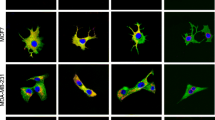Abstract
Sperm-associated antigen 9 (SPAG9) was recently reported to be overexpressed in several cancers and associated with the malignant behavior of cancer cells. However, the expression pattern of SPAG9 and its clinical significance in human prostate cancer have not been reported. In the present study, we analyzed SPAG9 expression in human prostate cancer tissues by immunohistochemistry and found that SPAG9 was overexpressed in 36.5 % of prostate cancer specimens. There was a significant association between SPAG9 overexpression and tumor stage (p = 0.0020) and Gleason score (p = 0.0377). Transfection of SPAG9 plasmid was performed in PC-3 cell line and siRNA knockdown was carried out in DU145 cells. Colony formation and MTT showed that SPAG9 overexpression promoted while siRNA knockdown inhibited prostate cancer cell proliferation. In addition, we found that SPAG9 could regulate cyclin D1 and cyclin E protein expression. In conclusion, SPAG9 is overexpressed in human prostate cancers and contributes to prostate cancer cell growth, possibly through cyclin protein regulation.


Similar content being viewed by others
References
Siegel R, Naishadham D, Jemal A. Cancer statistics. CA Cancer J Clin. 2012;62(1):10–29.
Yaqinuddin A, Qureshi SA, Pervez S, Bashir MU, Nazir R, Abbas F. Frequent DNA hypermethylation at the RASSF1A and APC gene loci in prostate cancer patients of Pakistani Origin. ISRN Urol. 2013;2013:627249.
Amin KS, Banerjee PP. The cellular functions of RASSF1A and its inactivation in prostate cancer. J Carcinog. 2012;11:3.
Syeed N, Syed Sameer A, Hamid A, Shah ZA, Afroze D, Rasool R, et al. Promoter methylation profile of GSTP1 and RASSF1A in benign hyperplasia and metastatic prostate cancer patients in a Kashmiri population. Mol Med Rep. 2010;3(5):883–7.
Ando K, Uemura K, Kuzuya A, Maesako M, Asada-Utsugi M, Kubota M, et al. N-cadherin regulates p38 MAPK signaling via association with JNK-associated leucine zipper protein: implications for neurodegeneration in Alzheimer disease. J Biol Chem. 2013;286(9):7619–28.
Kashef K, Lee CM, Ha JH, Reddy EP, Dhanasekaran DN. JNK-interacting leucine zipper protein is a novel scaffolding protein in the Galpha13 signaling pathway. Biochemistry. 2005;44(43):14090–6.
Lee CM, Onesime D, Reddy CD, Dhanasekaran N, Reddy EP. JLP: A scaffolding protein that tethers JNK/p38MAPK signaling modules and transcription factors. Proc Natl Acad Sci U S A. 2002;99(22):14189–94.
Nguyen Q, Lee CM, Le A, Reddy EP. JLP associates with kinesin light chain 1 through a novel leucine zipper-like domain. J Biol Chem. 2005;280(34):30185–91.
Takaesu G, Kang JS, Bae GU, Yi MJ, Lee CM, Reddy EP, et al. Activation of p38alpha/beta MAPK in myogenesis via binding of the scaffold protein JLP to the cell surface protein Cdo. J Cell Biol. 2006;175(3):383–8.
Kanojia D, Garg M, Gupta S, Gupta A, Suri A. Sperm-associated antigen 9, a novel biomarker for early detection of breast cancer. Cancer Epidemiol Biomarkers Prev. 2009;18(2):630–9.
Garg M, Kanojia D, Suri S, Suri A. Small interfering RNA-mediated down-regulation of SPAG9 inhibits cervical tumor growth. Cancer. 2009;115(24):5688–99.
Garg M, Kanojia D, Salhan S, Suri S, Gupta A, Lohiya NK, et al. Sperm-associated antigen 9 is a biomarker for early cervical carcinoma. Cancer. 2009;115(12):2671–83.
Garg M, Kanojia D, Suri S, Gupta S, Gupta A, Suri A. Sperm-associated antigen 9: a novel diagnostic marker for thyroid cancer. J Clin Endocrinol Metab. 2009;94(11):4613–8.
Kanojia D, Garg M, Gupta S, Gupta A, Suri A. Sperm-associated antigen 9 is a novel biomarker for colorectal cancer and is involved in tumor growth and tumorigenicity. Am J Pathol. 2011;178(3):1009–20.
Yi F, Ni W, Liu W, Pan X, Han X, Yang L, et al. SPAG9 is overexpressed in human astrocytoma and promotes cell proliferation and invasion. Tumour Biol. 2013;34(5):2849–55.
Wang Y, Dong Q, Miao Y, Fu L, Lin X, Wang E. Clinical significance and biological roles of SPAG9 overexpression in non-small cell lung cancer. Lung Cancer. 2013;81(2):266–72.
Garg M, Kanojia D, Khosla A, Dudha N, Sati S, Chaurasiya D, et al. Sperm-associated antigen 9 is associated with tumor growth, migration, and invasion in renal cell carcinoma. Cancer Res. 2008;68(20):8240–8.
Jagadish N, Rana R, Selvi R, Mishra D, Garg M, Yadav S, et al. Characterization of a novel human sperm-associated antigen 9 (SPAG9) having structural homology with c-Jun N-terminal kinase-interacting protein. Biochem J. 2005;389(Pt 1):73–82.
Gantulga D, Tuvshintugs B, Endo Y, Takino T, Sato H, Murakami S, et al. The scaffold protein c-Jun NH2-terminal kinase-associated leucine zipper protein regulates cell migration through interaction with the G protein G(alpha 13). J Biochem. 2008;144(6):693–700.
Kashef K, Radhakrishnan R, Lee CM, Reddy EP, Dhanasekaran DN. Neoplastic transformation induced by the gep oncogenes involves the scaffold protein JNK-interacting leucine zipper protein. Neoplasia. 2011;13(4):358–64.
Chakraborti S, Mandal M, Das S, Mandal A, Chakraborti T. Regulation of matrix metalloproteinases: an overview. Mol Cell Biochem. 2003;253(1–2):269–85.
Kanojia D, Garg M, Saini S, Agarwal S, Parashar D, Jagadish N, et al. Sperm-associated antigen 9 plays an important role in bladder transitional cell carcinoma. PLoS One. 2013;8(12):e81348.
Hunter T, Pines J. Cyclins and cancer. II: Cyclin D and CDK inhibitors come of age. Cell. 1994;79(4):573–82.
Musgrove EA, Caldon CE, Barraclough J, Stone A, Sutherland RL. Cyclin D as a therapeutic target in cancer. Nat Rev Cancer. 2011;11(8):558–72.
Liu Y, Wang L, Lin XY, Wang J, Yu JH, Miao Y, et al. The transcription factor DEC1 (BHLHE40/STRA13/SHARP-2) is negatively associated with TNM stage in non-small-cell lung cancer and inhibits the proliferation through cyclin D1 in A549 and BE1 cells. Tumour Biol. 2013;34(3):1641–50.
Liu J, Liao Q, Zhang Y, Sun S, Zhong C, Liu X. Cyclin D1 G870A polymorphism and lung cancer risk: a meta-analysis. Tumour Biol. 2012;33(5):1467–76.
Vizkeleti L, Ecsedi S, Rakosy Z, Orosz A, Lazar V, Emri G, et al. The role of CCND1 alterations during the progression of cutaneous malignant melanoma. Tumour Biol. 2012;33(6):2189–99.
Acknowledgement
The study was supported by the Outstanding Scientific Fund of Shengjing Hospital (no. 201205).
Conflict of interest
None.
Author information
Authors and Affiliations
Corresponding author
Rights and permissions
About this article
Cite this article
Li, H., Peng, Y., Niu, H. et al. SPAG9 is overexpressed in human prostate cancer and promotes cancer cell proliferation. Tumor Biol. 35, 6949–6954 (2014). https://doi.org/10.1007/s13277-014-1947-4
Received:
Accepted:
Published:
Issue Date:
DOI: https://doi.org/10.1007/s13277-014-1947-4




